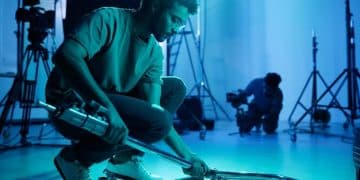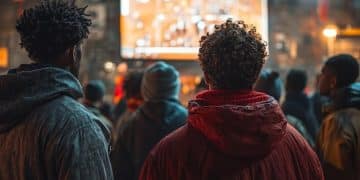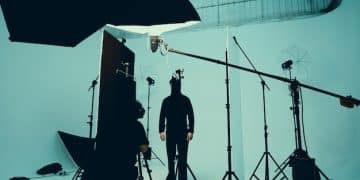2025’s 5 Innovative Short Film Techniques: A Director’s Guide
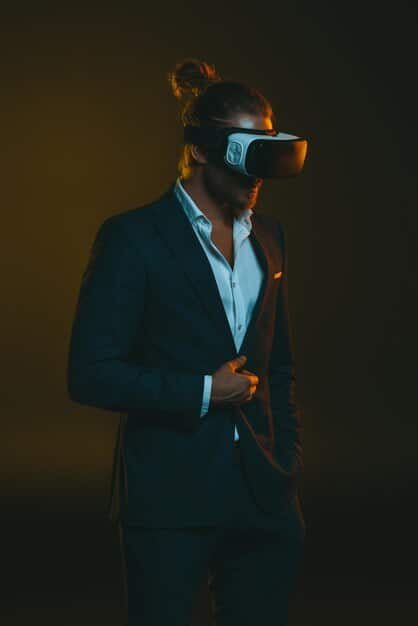
Directors seeking to elevate their craft in 2025 must explore five cutting-edge short film techniques: volumetric capture storytelling, AI-driven adaptive narratives, haptic feedback integration, augmented reality world-building, and bioluminescent cinematography. These innovations offer unprecedented creative control and immersive audience experiences, pushing the boundaries of traditional filmmaking.
The landscape of filmmaking is in constant flux, with technology and creative vision continually pushing boundaries. For directors aiming to stay at the forefront of this evolution, understanding the most impactful innovations is paramount. This guide to Unveiling the 5 Most Innovative Short Film Techniques of 2025: A Director’s Guide offers a deep dive into the methods that will define the next generation of visual storytelling, ensuring your projects resonate powerfully with audiences.
Embracing Volumetric Capture Storytelling
The shift towards more immersive and dynamic cinematic experiences is undeniable, and at its heart lies volumetric capture storytelling. This technique transcends traditional 2D filmmaking, allowing for the recording of three-dimensional performances, objects, and environments with unprecedented depth and detail. No longer are we confined to flat planes; instead, characters exist within a fully explorable space, offering directors unparalleled freedom in post-production and audience interaction.
For short films, this means a revolution in how narratives can be constructed and consumed. Imagine a scene where a character delivers a monologue, and the audience, through an interactive viewing platform, can walk around them, observing subtle nuances from every angle. This level of intimacy and control wasn’t possible before, opening doors to narrative structures that are less linear and more experiential. It’s about building worlds where every perspective offers a new layer of meaning.
The Technical Edge of Volumetric Capture
Volumetric capture relies on a sophisticated array of cameras and sensors that simultaneously record subjects from multiple viewpoints. This data is then processed into a 3D model, complete with texture and motion, which can be manipulated in various virtual environments. The fidelity of these captures is rapidly improving, making them indistinguishable from reality in many contexts. Directors can now “re-stage” a performance infinitely, adjusting lighting, camera angles, and even the digital environment long after the original shoot.
- Enhanced Realism: Captures true depth and spatial relationships, eliminating planar limitations.
- Post-Production Flexibility: Allows for endless virtual camera movements and lighting adjustments.
- Interactive Narratives: Fundamental for creating immersive experiences where viewers control perspective.
- Future-Proofing Content: Ideal for VR, AR, and virtual production pipelines.
Practical Applications in Short Films
From indie dramas experimenting with intimate, multi-perspective character studies to sci-fi shorts creating hyper-realistic holographic beings, volumetric capture offers a palette of possibilities. It enables the crafting of “living archives” of performances, ensuring that an actor’s portrayal isn’t just a recording but a spatial asset that can be revisited and integrated into various projects. Directors are finding creative ways to blend traditional footage with captured volumetric elements, creating hybrid visuals that feel both grounded and otherworldly. This technique is not just about showing; it’s about inviting the audience to inhabit the story’s space.
The financial barriers to entry are decreasing, with more accessible software and hardware solutions emerging. This democratizes a once-exclusive technology, allowing independent filmmakers to experiment and innovate. The storytelling potential is vast, enabling directors to break free from conventional cinematographic grammar and invent new forms of visual communication.
In conclusion, volumetric capture is not merely a technical upgrade; it’s a paradigm shift in how stories are told and experienced. For short film directors, mastering this technique means delivering narratives that are not just seen, but truly inhabited, offering an unparalleled level of immersion and creative control. It marks a significant step towards the cinematic experiences of tomorrow.
AI-Driven Adaptive Narratives: A New Frontier
The concept of AI-driven adaptive narratives is poised to redefine storytelling in short films, moving beyond linear structures to dynamic ones that respond to audience input or predefined parameters. This innovative technique allows films to branch, offering different perspectives, plot developments, or even endings based on viewer choices, environmental data, or even biometric feedback. It’s a fundamental reimagining of the passive viewing experience, transforming it into an interactive journey.
For directors, this presents a fascinating challenge and opportunity: to design stories that are frameworks rather than fixed paths. Instead of crafting a single story, one must now consider multiple possibilities, constructing narratives that can fluidly adjust while maintaining thematic coherence. This demands a new approach to scriptwriting, shot composition, and character development, where consistency across various branches becomes key.
How AI Powers Adaptivity
At its core, AI-driven adaptive narrative relies on algorithms that analyze inputs and trigger corresponding changes in the narrative flow. This can range from simple “choose your own adventure” style selections to complex systems that adapt based on a viewer’s emotional response, tracked through facial expressions or heart rate monitors. The AI acts as a sophisticated editor, weaving together pre-shot segments or even generating new content in real-time within the established parameters.
This requires directors to anticipate a multitude of outcomes and prepare visual and auditory assets for each. The complexity is significant, but the reward is an unparalleled level of personalization and engagement, making each viewing a unique experience.
- Personalized Viewing: Tailors story elements based on viewer interaction or data.
- Enhanced Engagement: Transforms passive viewers into active participants.
- Complex Story Structures: Requires intricate narrative design to ensure coherence across branches.
- Dynamic Content Generation: Potential for AI to create new scenes or dialogue in real-time.
Crafting Branching Short Film Experiences
Short films are an ideal format for experimenting with adaptive narratives due to their concise nature. A director might explore different character fates, delve deeper into a subplot based on viewer interest, or even change the film’s genre mid-way through. The challenge lies in ensuring that despite the variability, the core message or emotional arc remains impactful. This involves designing strong anchor points that ground the experience, regardless of the branching paths.
For instance, a short film exploring a moral dilemma could offer options that lead to vastly different ethical conclusions, prompting viewers to reflect on their own values. The narrative architecture becomes a puzzle, where every piece must fit into multiple potential configurations, yet still form a complete picture.
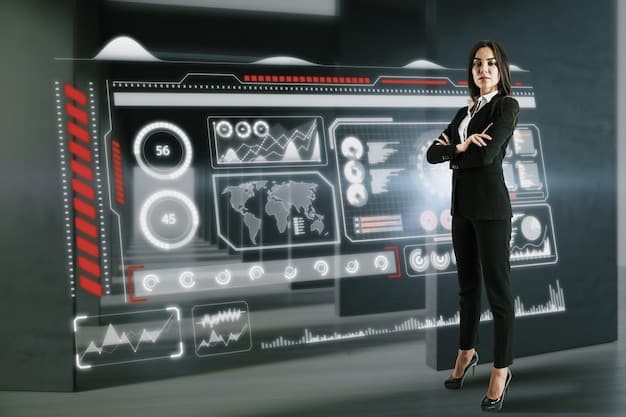
The evolution of generative AI tools means that some aspects of dynamic content creation are becoming more accessible. While fully AI-generated films are still a distant prospect, AI can assist in constructing adaptive elements, suggesting branching points, or even generating minor scene variations, easing the burden on filmmakers. The ability to create a story that literally “responds” to its audience is a groundbreaking shift, promising a more intimate and unforgettable cinematic relationship.
In essence, AI-driven adaptive narratives empower directors to build living stories. It’s about moving from storytelling to story-experiencing, where the audience is not just watching a film but actively shaping it, making each viewing a unique, personal journey.
Integrating Haptic Feedback for Sensory Immersion
The pursuit of heightened realism and audience immersion in short films is taking a new direction with the integration of haptic feedback. This innovation moves beyond traditional sight and sound, engaging the sense of touch to create a truly multi-sensory cinematic experience. Imagine feeling the subtle vibrations of a distant explosion, the rhythmic thumping of a character’s anxious heartbeat, or the gentle rustling of leaves in a serene forest scene, all synchronized with the on-screen action.
Haptic feedback introduces a new layer of emotional and situational depth, allowing directors to evoke visceral responses that were previously unattainable. It’s about breaking through the screen and letting the audience not just see and hear the story, but physically feel elements of its world. This adds tremendous power to a director’s expressive toolkit, enabling them to underscore key moments with tactile sensations that resonate deeply.
The Mechanics of Tactile Storytelling
Haptic technology, often delivered through wearable devices or specialized seating, uses vibrations and other physical stimuli to simulate touch sensations. These systems can be precisely programmed to align with specific on-screen events, varying in intensity, frequency, and pattern to convey different types of physical sensations. The goal is to enhance the narrative, not distract from it, making the haptic cues subtle yet impactful.
For a director, this means choreographing not just visual and auditory elements, but also tactile ones. It requires a thoughtful integration into the sound design process, often mapping haptic cues to specific audio frequencies or temporal events within the film. The careful calibration ensures that the haptic sensations enhance the emotional resonance and atmosphere, drawing the viewer deeper into the story without overwhelming them.
- Deepened Immersion: Engages the often-overlooked sense of touch, enhancing realism.
- Emotional Resonance: Allows for tactile reinforcement of emotional beats and dramatic tension.
- Expanded Storytelling Tools: Directors can use touch to convey atmosphere, impact, and character states.
- Technological Advancement: Relies on wearable tech and specialized hardware for delivery.
Designing Tactile Experiences for Short Films
Short films, with their focused narratives, are an excellent medium for exploring the potential of haptic feedback. A director can use haptics to emphasize a crucial moment – perhaps the impact of a fall, the warmth of a character’s embrace, or the chilling sensation of a ghostly presence. The brevity of the format allows for precise experimentation, ensuring that every haptic cue serves a clear narrative purpose.
Consider a horror short where the haptic feedback might simulate the crawling of unseen creatures, or a drama where it emphasizes the gentle touch between two lovers. These subtle additions can profoundly alter the audience’s psychological and emotional engagement, making the film a truly felt experience. The challenge lies in avoiding novelty for its own sake and ensuring that the haptic elements genuinely contribute to the storytelling, rather than detraindo from it.
As haptic technology becomes more refined and ubiquitous, its integration into filmmaking will become more seamless. Directors who learn to master this multi-sensory language will be able to craft short films that leave a lasting, physical impression, pushing the boundaries of what cinematic immersion truly means.
Augmented Reality World-Building in Short Films
The rise of augmented reality (AR) world-building offers short film directors an unprecedented opportunity to blend digital enhancements with real-world environments, creating visually stunning and conceptually rich narratives. Unlike virtual reality which fully immerses the viewer in a fabricated world, AR overlays digital information onto the real world, allowing filmmakers to craft narratives where the boundaries between the tangible and the fantastical elegantly blur.
This technique is not merely about adding visual effects; it’s about constructing narrative layers that interact with physical spaces, transforming ordinary locations into extraordinary settings. For short films, this means that even a simple urban street can be imbued with magical elements, historical echoes, or futuristic interfaces, broadening the scope of storytelling without requiring massive physical sets. Directors can leverage AR to create dynamic backdrops that evolve with the story, offering a fresh perspective on environmental storytelling.
The Fundamentals of AR Integration
AR world-building in filmmaking involves meticulously planning digital overlays that will seamlessly integrate with live-action footage. This typically uses advanced computer vision and tracking technologies to ensure that virtual elements remain anchored and correctly scaled within the real environment as the camera moves. The digital assets can range from subtle informational graphics to complex animated characters or entire architectural structures.
For directors, this requires a synergy between artistic vision and technical execution. The challenge is to conceive of scenes where the physical and digital components enhance each other, creating a cohesive visual language. The meticulous pre-visualization and concept art become even more critical, ensuring that the AR elements contribute meaningfully to the narrative and aesthetics, rather than appearing as mere add-ons.
- Seamless Blending: Integrates digital assets into real-world environments.
- Dynamic Environments: Transforms ordinary locations into fantastical or futuristic settings.
- Reduced Production Costs: Minimizes the need for elaborate physical sets.
- Interactive Storytelling Potential: Opens up avenues for audience interaction with AR elements.
Creative Applications in Short Film Narratives
Short films can harness AR world-building to tell stories that are inherently about perception, reality, and the interplay between them. A common urban setting could reveal hidden magical creatures to a protagonist, or a barren landscape could be filled with holographic memories of a lost civilization. AR allows directors to portray internal states externally, making a character’s fears or hopes manifest within their perceived reality.
Consider a short film where the protagonist’s anxiety literally manifests as digital cracks appearing on the walls around them, or a love story where shared memories materialize as fleeting AR projections in their favorite cafe. This technique encourages innovative visual metaphors and narrative constructs, pushing filmmakers to think about space and information in new ways.
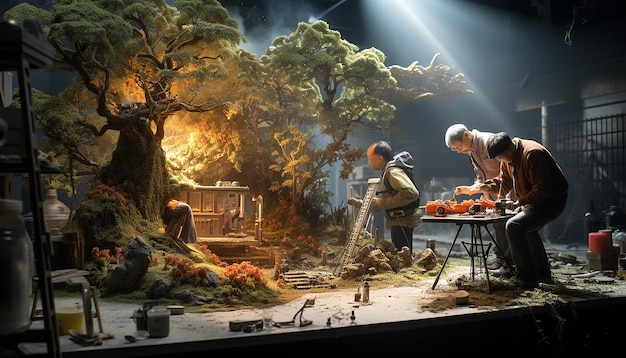
The evolution of AR viewing devices, from specialized glasses to mobile interfaces, means that the potential for audience engagement is vast. Directors can explore narratives that are experienced not just on a screen, but potentially within the viewer’s own environment, making the short film a portable, interactive piece of art. AR world-building is not just a visual trick; it is a profound tool for reimagining cinematic spaces and the stories they can hold.
By embracing augmented reality, short film directors can create layers of meaning and visual spectacle that challenge conventional notions of reality, offering audiences an imaginative blend of the familiar and the extraordinary.
Mastering Bioluminescent Cinematography
As filmmakers increasingly seek new aesthetic palettes, bioluminescent cinematography emerges as a truly groundbreaking technique for crafting visually stunning and narratively impactful short films. This involves either capturing naturally occurring bioluminescence (from organisms like certain fungi, insects, or marine life) or meticulously recreating its ethereal glow through advanced lighting and practical effects. The result is a dreamlike, otherworldly luminescence that can evoke wonder, mystery, or even a subtle sense of dread, offering a unique visual signature that stands apart from conventional lighting.
For directors, mastering this technique means understanding the nuances of low-light shooting, advanced lighting design, and often, specialized camera equipment capable of high sensitivity. It’s about painting with light that pulsates, glows, and shimmers, creating an atmosphere that is deeply immersive and emotionally resonant. This approach moves beyond artificial light sources to harness the inherent magic of biological illumination or its convincing facsimile.
The Art and Science of Bioluminescent Effects
Achieving compelling bioluminescent cinematography can involve several methods. One approach is shooting in environments where natural bioluminescence occurs, requiring incredible patience and technical expertise to capture their fleeting beauty. Another, more common method involves using practical effects, such as luminescent paints, LED technologies mimicking organic light, or specifically designed visual effects (VFX) that integrate seamlessly with the live-action footage.
The key for directors is to use bioluminescence not just as a pretty effect, but as a narrative tool. How does the glow reveal character? What emotions does it evoke? Does it signify danger, hope, or a hidden world? The careful integration of these luminous elements can imbue a scene with profound symbolic meaning. It often involves a collaborative effort between the director, cinematographer, and visual effects artists to ensure the bioluminescent elements serve the story’s overall vision.
- Ethereal Aesthetics: Creates unique, otherworldly visual atmospheres.
- Narrative Symbolism: Bioluminescence can represent abstract concepts like hope, danger, or purity.
- Technical Challenges: Requires expertise in low-light shooting and specialized equipment.
- Practical and Digital Methods: Can be achieved through natural capture, practical effects, or advanced VFX.
Storytelling through Luminous Worlds
Short films are perfectly suited for experimenting with bioluminescent cinematography due to their contained scope and often symbolic nature. A director might create a short sci-fi piece set on an alien planet where the flora and fauna glow, emphasizing its strangeness and beauty. Or a fantasy film could depict ancient magical rituals illuminated by glowing runes and mystical creatures. The technique is particularly powerful for conveying a sense of otherness or heightened reality.
Imagine a dramatic short where a character’s inner turmoil is subtly reflected in the pulsating bioluminescence of a surrounding forest, or a poetic piece where memories are evoked through fleeting luminous trails. This visual language can communicate complex ideas and emotions without relying heavily on dialogue, making the imagery itself a primary storyteller. The unique visual signature of bioluminescence ensures that the film will be instantly recognizable and memorable, leaving a strong impression on the audience.
By focusing on bioluminescent cinematography, directors can unlock new dimensions of visual storytelling. It’s about more than just lighting a scene; it’s about infusing it with a living, breathing light that speaks directly to the audience’s imagination and emotions, creating truly magical and original cinematic narratives.
The Intersection of Techniques: Hybrid Filmmaking
While each of the five techniques discussed—volumetric capture, AI-driven narratives, haptic feedback, augmented reality world-building, and bioluminescent cinematography—offers profound creative potential independently, their true power for short film directors often lies in their strategic **intersection**. Hybrid filmmaking, the practice of combining these innovative methods, allows for the creation of experiences that are exponentially more immersive, dynamic, and visually striking. This holistic approach capitalizes on the strengths of each technique to build layered, multi-sensory narratives previously unimaginable.
For a director, this means thinking beyond single innovations and considering how elements like an AR-enhanced environment can host volumetric characters, all while the audience feels the story through haptic feedback and navigates an AI-adaptive plot illuminated by bioluminescent elements. The complexity grows, but so does the potential for truly groundbreaking cinematic artistry that sets new standards for audience engagement. It’s about orchestrating a symphony of sensations and interactions.
Synergistic Storytelling Through Blended Innovations
Consider a short film that uses volumetric capture to bring a fantastical creature to life. This creature then interacts with an augmented reality overlay on a real-world set, making it appear as if it truly exists within our environment. The narrative could be AI-driven, offering different interactions with the creature based on the viewer’s preferences, while critical moments are underscored with haptic feedback, allowing the audience to feel the creature’s massive footsteps or its gentle touch. All of this could unfold within a forest subtly illuminated by carefully crafted bioluminescent effects, enhancing the magical realism.
This kind of synthesis elevates the audience experience from passive observation to active participation. Each technology complements the others, building a cohesive and deeply engaging world. The technical harmony requires careful pre-production, including extensive storyboarding, technical rehearsals, and an integrated post-production pipeline that accounts for all these disparate elements.
- Heightened Immersion: Combines multiple sensory inputs for a richer experience.
- Complex Narrative Structures: Allows for dynamic, interactive, and visually stunning storytelling.
- Maximized Creative Freedom: Directors can mix and match techniques to achieve specific artistic visions.
- Future-Forward Filmmaking: Sets a benchmark for innovative content creation in 2025 and beyond.
Navigating the Challenges of Hybrid Production
While the creative rewards are immense, integrating multiple cutting-edge techniques also presents significant production challenges. Directors must manage teams specialized in diverse fields—from volumetric data artists to haptics designers and AI narrative architects. Budgetary constraints for independent short films can be a factor, though the trend towards more accessible tools and software helps mitigate this. The learning curve for embracing these technologies collectively can be steep, requiring a willingness to experiment and iterate.
However, the payoff is a short film that doesn’t just tell a story, but creates an unforgettable, multi-dimensional event for the audience. This integrated approach positions directors at the vanguard of cinematic innovation, capable of producing narratives that are not just seen and heard, but truly felt, experienced, and even influenced. Hybrid filmmaking is the future, offering a canvas where imagination is the only limit to what can be created and shared.
In conclusion, the intersection of these innovative techniques provides a fertile ground for short film directors to explore new forms of expression. By strategically combining volumetric capture, AI-driven narratives, haptic feedback, AR world-building, and bioluminescent cinematography, creators can push the boundaries of storytelling, delivering experiences that are both profoundly artistic and deeply engaging for audiences in 2025 and beyond.
| Key Technique | Brief Description |
|---|---|
| ✨ Volumetric Capture | Records 3D performances for immersive, rotatable viewing. |
| 🧠 AI Adaptive Narratives | Stories that branch or change based on audience interaction. |
| 🖐️ Haptic Feedback | Integrates touch sensations for deeper sensory immersion. |
| 🌐 AR World-Building | Blends digital elements into real-world settings for dynamic visuals. |
Frequently Asked Questions About Innovative Short Film Techniques (2025)
Volumetric capture records performers and objects in 3D, allowing directors to manipulate camera angles and lighting in post-production with unprecedented freedom. For short films, it creates highly immersive and interactive content, enabling audiences to view scenes from multiple perspectives, pushing the boundaries of traditional linear storytelling and enhancing realism.
AI-driven adaptive narratives allow short films to evolve based on viewer choices, making each viewing a unique experience. By offering branching storylines or personalized content, these techniques transform passive spectators into active participants, deepening their immersion and emotional connection to the unfolding story, thus leading to greater overall engagement.
Haptic feedback integrates the sense of touch into the cinematic experience, using vibrations and physical stimuli to sync with on-screen actions. This allows directors to evoke visceral responses, such as feeling an explosion’s tremor or a character’s heartbeat, profoundly enhancing emotional resonance and immersion, going beyond visual and auditory stimulation.
Augmented reality (AR) world-building overlays digital elements onto real-world environments, creating dynamic and interactive sets without extensive physical construction. Unlike traditional set design, AR can transform ordinary locations into fantastical scenes with minimal real-world intervention, offering directors immense flexibility and cost savings while expanding creative possibilities in any setting.
Bioluminescent cinematography creates unique, ethereal visual atmospheres using natural glowing organisms or simulated effects. It offers directors a distinct aesthetic palette to convey mystery, wonder, or specific emotional tones without relying on conventional lighting. This technique allows filmmakers to craft visually stunning narratives that leave a lasting, almost magical impression on the audience.
Conclusion
The world of short film creation in 2025 stands at an exciting precipice, with technological advancements ushering in an era of unprecedented expressive power for directors. From the multi-dimensional immersion of volumetric capture to the responsive narratives enabled by AI, the tactile engagement of haptic feedback, the boundless imagination of augmented reality world-building, and the enchanting aesthetics of bioluminescent cinematography, these techniques collectively redefine what is possible on screen. Directors who embrace and creatively integrate these innovations will not only captivate their audiences but also play a pivotal role in shaping the future of cinematic storytelling, crafting films that are not just watched, but deeply experienced and remembered.
